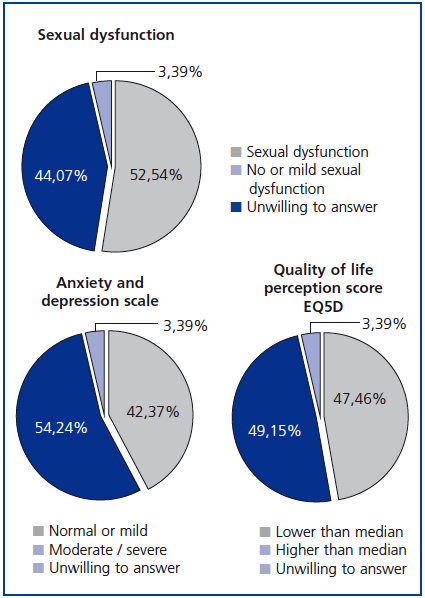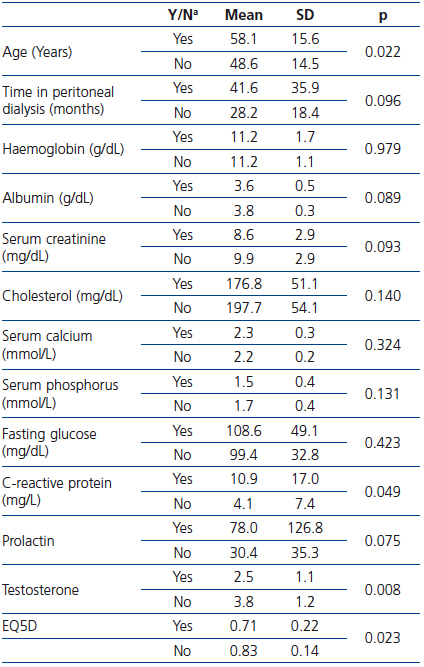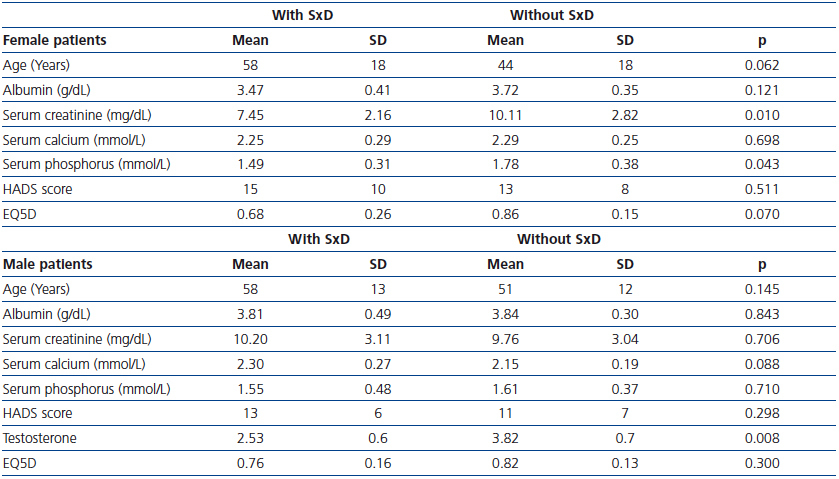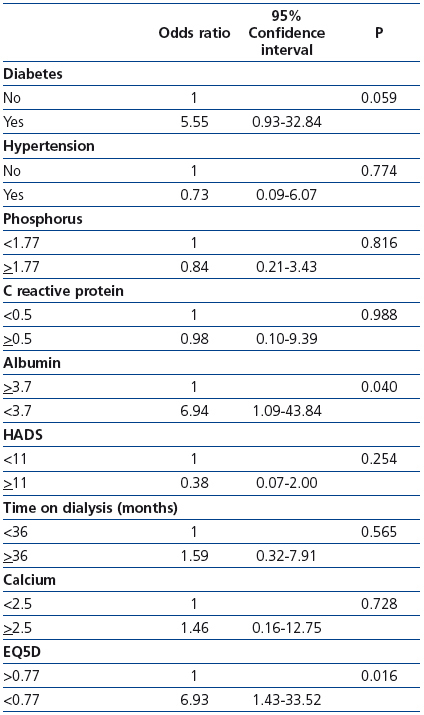Background: Sexual function, psychosocial status and quality of life (QoL) are important dimensions, often underestimated, in dialysis treatment schedules. Objectives: The aim of this study was to evaluate the prevalence of sexual dysfunction and its associations, among peritoneal dialysis (PD) patients. Methods: The Index of Female Sexual Function (IFSF), the International Index of Erectile Function (IIEF), the Hospital Anxiety and Depression Scale (HADS) and the Quality of Life EQ5D questionnaires were applied to a prevalent PD population of 57 enrolled patients. Multivariate analysis was conducted to investigate clinical independent risk factors for sexual dysfunction. Results: Sexual dysfunction was diagnosed in 67.9% of women and 44.8% of men. In females, serum albumin, creatinine and phosphorus levels and EQ5D positively correlated with IFSF score. For males, there was a significant negative correlation between serum calcium levels and the IIEF score. On multivariate analysis, nutritional parameters remained independently associated with sexual dysfunction in women; in males, increase in calcium concentration and decrease of testosterone were main determinants. On logistic regression analysis, the risk of sexual dysfunction in global population was associated with lower values of albumin (OR=6.94) and with a lower QoL score EQ5D (OR=6.93). Conclusions: Sexual dysfunction is highly prevalent and strongly associated with impaired QoL of PD patients. Different clinical variables were related to sexual dysfunction in each gender, justifying an individualized preventive and therapeutic approaches.
Introducción: La sexualidad, el estatus psicosocial y la calidad de vida (QoL) son factores importantes, a menudo infravalorados, en los esquemas de diálisis. Objetivos: Evaluar la prevalencia de disfunción sexual y sus asociaciones en los pacientes en diálisis peritoneal (DP). Métodos: Se utilizaron el Índice de Función Sexual Femenina (IFSF), el Índice Internacional de Función Eréctil (IIFE), la Escala de Ansiedad y Depresión Hospitalaria (HADS) y los cuestionarios sobre calidad de vida EQ5D en la población prevalente en DP (57 pacientes). Se realizaron análisis multivariantes para investigar los factores clínicos independientes para disfunción sexual. Resultados: Se diagnosticó disfunción sexual en el 67,9 % de las mujeres y en el 44,8 % de los varones. En las mujeres la albúmina sérica, la creatinina, los niveles de fósforo y EQ5D se relacionaran positivamente con IFSF. En los varones existía una correlación negativa entre el calcio sérico y el score IIEF. En el análisis multivariante los parámetros nutricionales permanecieron asociados de manera independiente con la disfunción sexual en mujeres; en los varones los principales determinantes fueron el aumento de la concentración de calcio y la disminución de la testosterona. En los análisis de regresión logística el riesgo de disfunción sexual en la población global está asociado a niveles menores de albúmina (OR = 6,94) y a un score inferior de EQ5D (OR = 6,93). Conclusiones: La disfunción sexual tiene una alta prevalencia y una fuerte asociación con la percepción de la calidad de vida de los pacientes en DP. Se han encontrado diferentes variables clínicas relacionadas con la disfunción sexual en cada sexo que justifican actitudes preventivas y terapéuticas individualizadas.
INTRODUCTION
The prevalence of sexual dysfunction is significantly higher in end-stage renal disease patients than in the age matched general population and usually begins much earlier than CKD stage 5.1,2. Despite its impact, the problem of sexual dysfunction has often been neglected in dialysis patients3 and studies dedicated to this topic are rare, particularly in peritoneal dialysis (PD). Furthermore, the vast majority of the studies preferentially discuss the erectile dysfunction (ED), rarely addressing female sexual dysfunction.3-5
Sexual dysfunction is a complex problem involving clinical and treatment-related factors, including psychosocial factors, hormonal imbalance, neurogenic and vascular disease and drugs side-effects, all known common factors in dialysis patients.4,6 However, the risk factors in this particular population are not well documented, particularly in PD patients.5 Furthermore, depression, anxiety, quality of life (QoL) and sexual dysfunction are strongly interconnected, with major impact on patient outcomes. Therefore, these parameters deserve a focus on clinical investigation towards a better and individualized care.7,8
The aims of the study are to examine sexual dysfunction in patients on maintenance PD, using self reported questionnaires, and to investigate independent factors for sexual dysfunction among PD technique, clinical and psychological variables.
SUBJECTS AND METHODS
All chronic PD patients in Centro Hospitalar do Porto, Portugal, under stable medical condition and ambulatory treatment, were considered for inclusion. The study patients were restricted to ages 18-85 years, who had received maintenance dialysis therapy for at least 3 months. The study was conducted between January and March 2012. All patients gave their informed consent.
They had no evidence of acute psychiatric disease, acute infections, such as peritonitis, uncontrolled congestive heart failure or acute complications of uremia at the time of the study. Biochemical and hematologic parameters, as well as dialysis clearance data of all patients were obtained. Other clinical variables, including duration on PD, marital status, education level, employment status, comorbidities, primary renal disease and medication in use, were also documented.
Questionnaires
Each patient was asked to complete a self reported questionnaire – the International Index of Erectile Function (IIEF) for men9 and the Index of Female Sexual Function (IFSF) for women,3 so that sexual function could be assessed. Both groups filled the Hospital Anxiety and Depression Scale (HADS) and the EuroQOL (EQ5D), to measure depressive symptoms and address QoL, respectively.10
The IIEF is a multi-dimensional validated self-report questionnaire that evaluates male sexual function. Currently, IIEF has been validated in 32 languages and has been used as a primary endpoint in more than 50 clinical studies.9 It comprises 15 items, divided into 5 domains of sexual function: erectile function (6 items), intercourse satisfaction (3 items), orgasmic function (2 items), sexual desire (2 items) and overall satisfaction (2 items). The severity of sexual dysfunction is divided into five groups, according to the overall score: no sexual dysfunction (26-30), mild sexual dysfunction (22-25), mild to moderate sexual dysfunction (17-21), moderate sexual dysfunction (11-16) and severe sexual dysfunction (6-10), with a higher score indicating better sexual function.
The IFSF, a 19-item questionnaire, was designed to assess sexual function in women. It includes 6 domains: desire, arousal, lubrication, orgasm, global satisfaction and pain. Each domain is given a maximum score of 6. A woman with normal sexual function displays the highest score of 36, with lower scores revealing a worse sexual function. A score less than 26.55 indicates female sexual dysfunction. Similarly to IIEF, the IFSF has been used in several studies to evaluate sexual dysfunction in dialysis patients.3
The HADS is a brief and simple fourteen item scale. Seven items relate to anxiety and other seven to depression. Responses are scored on a scale of 0-3, with 3 indicating high symptom frequency. The score for each subscale (anxiety and depression) can range from 0-21, with scores categorized as follows: normal (0-7), mild (8-10), moderate (11-14), severe (15-21). A key point that distinguishes HADS from other depression scales is that the former excludes all overlapping symptoms of anxiety or depression related to physical illnesses, to prevent the interference of somatic disorders in scale score.
The EQ-5D is a short, easy to use and flexible five-question questionnaire that measures health-related QoL.10 Permission to use this questionnaire was obtained from the Euroqol group.
To assess the impact of specific PD technique in sexuality, we conducted an additional question: “to which extent the use of the peritoneal catheter and/or PD modality impairs sexuality?”.
The surveys were self-administered on a pen-and-paper basis, in a single session, coinciding with one medical appointment. All questionnaires were carried out individually and confidentially and were collated with de-identified sociodemographic and clinical data. Only a minority of patients required health professionals help to clarify some questions. On average, the questionnaires were fulfilled in 15 minutes.
Statistical analysis
Continuous variables were described by mean and standard deviation and categorical variables by the absolute and relative frequency.
To compare means between continuous variables we used the Student's t test for independent samples. The χ2 or Fisher's exact test (when applicable) was used to analyze the association between two categorical variables.
Female and male patients were clustered as with or without sexual dysfunction, according to the Index of Female Sexual Function (IFSF) and the Index of Erectile Function (IIEF) cutoffs, respectively. To analyse correlations between continuous variables and scores of sexual dysfunction we used Pearson correlation.
To identify associations between continuous variables under study and the IIEF and IFSF scores as dependent variables we used multiple linear regression.
A multivariate logistic regression (enter method) was used to identify risk factors for sexual dysfunction in the global population. In the multivariate model we included the following variables: time on dialysis, diabetes, hypertension, serum phosphorus, C-reactive protein, albumin and calcium levels, HADS and EQ5D. Results are reported as adjusted OR and respective confidence intervals at 95%. For all multivariate logistic regression analyzes, continuous variables were categorized according to the average values or clinically relevant thresholds, usually applied as standard quality parameters.
Statistical tests were performed bilaterally considering a significance level of 5%. The statistical analysis was performed on IBM SPSS Statistics 20.0 software.
RESULTS
PD population, PD modality and prevalence of sexual dysfunction
A total of 58 PD patients were eligible for the study. Among them, only one female patient did not complete the questionnaires, because of unwillingness to answer sexuality questions, incorporating the study a total of 57 PD patients (28 women and 29 men).
The mean time on PD was 32.0±23.1 months for men and 39.7±36.0 months for women.
Regarding the mode of PD, there was a slight predominance of patients receiving automatic peritoneal dialysis (APD) (n=27, 52.4%) compared to continuous ambulatory peritoneal dialysis (CAPD). Mean Kt/V value was 2.3±0.7 and mean normalized weekly creatinine clearance was 50.8±35.0 liters. There were 14 (24.6%) patients (8 women/6 men) without residual renal function. Hypertension and diabetes mellitus were present in 89.5% and 24.6% of patients, respectively.
Drugs used for hypertension treatment were beta blockers (43.8%), angiotensin converting enzyme inhibitors (77.2%), calcium channel blockers (49.1%) and diuretics (70.1%). Mean hemoglobin was 11.4±1.7g/dL and 10.8±1.0g/dL for men and women, respectively. Erythropoiesis stimulating agents were used in 89.5% of patients.
The global prevalence and distribution of sexual dysfunction, anxiety and depression (HADS) and perception of quality of life (EQ5D) are present in Figure 1, showing that a relevant percentage of PD patients suffer from such health disturbances, hardly addressed in regular medical appointments.
The frequency of sexual dysfunction in this study was 44.8% for men and 67.9% for women, respectively (p=0.08). Overall, 19 women on PD reported FSFI scores consistent with sexual dysfunction. The median score was 15.8 (IQR, 2-34). Thirteen men on PD reported IIEF scores consistent with sexual dysfunction. The median score was 33.4 (IQR, 0-72). Notably 82.4% of the patients denied that PD catheter was a major issue affecting their sexuality.
Relevant clinical associations with sexual dysfunction in global population
Analyzing sample characteristics by sexual dysfunction (Table 1), we documented significant differences relative to age (p=0.02) and quality of life score (EQ5D) (p=0.02), with individuals with sexual dysfunction being older, with poorer QoL. Furthermore, other significant findings were related to sexual dysfunction: lower serum testosterone (p=0.008), higher C-reactive protein level (p=0.04), as well as a trend towards significance for higher prolactin level.
Differential associations of clinical variables and sexual dysfunction in male and female
Furthermore, the association of clinical variables and sexual dysfunction scores in subgroups, by FSFI and IIEF, were explored (Table 2). Distinctive correlations were identified, by gender (Table 3). In females, nutritional parameters and QoL perception were highlighted: increased serum albumin, creatinine and phosphorus levels and higher EQ5D score were associated with a higher IFSF score. For males there was a significant negative correlation between the concentration of calcium and the IIEF score. In multiple regression analyses, higher serum creatinine (p=0.001) and albumin (p=0.003) remained independently associated with a better IFSF score in females. In men, higher levels of testosterone (p=0.005) were significantly related to higher scores of IIEF. Inversely, higher serum calcium (p=0.016) was associated with lower IIEF scores.
A logistic regression analysis was performed in the global population, including major clinical variables, standard quality parameters and EQ5D. Diabetes, albumin and EQ5D were associated with sexual dysfunction in the study population (Table 4). The risk of having sexual dysfunction increased if diabetes was present (OR=5.55), if serum albumin was lower (OR=6.94) and with lower EQ5D scores (OR=6.93).
Relationship between standard PD quality parameters and sexual dysfunction
Sexual dysfunction scores revealed no significant association with KT/V urea, creatinine clearance or daily fluid removal.
DISCUSSION
Sexual dysfunction in dialysis patients is clinically relevant, but still lacks opportune diagnosis and treatment, with a paucity of specific studies in PD. Our study highlights the clinical associations of this complication in a contemporary PD population, while also addresses other relevant related dimensions of health in dialysis patients: anxiety, depression and QoL. Our study, according to other reports,4,11 demonstrates that sexual dysfunction is strongly associated with impaired QoL. However, we found that associated factors of sexual dysfunction in PD patients appear to have a different impact between genders pointing to the need of individualized preventive and therapeutic approaches.
Interestingly, besides expected factors such as age and diabetes, increased serum calcium level was associated with worsening sexual function in males, pointing to the main vascular etiology of erectile dysfunction in male PD patients. In the axis of CKD bone disease and vessels hypercalcemia is indeed related with vascular calcification and endothelial dysfunction. Only 34.5% of males had low serum testosterone levels. As we know, chronic renal disease is associated with disturbances of reproductive hormones, which may impair hypothalamic-pituitary function and contribute to sexual dysfunction in male patients.6,7 Moreover, low serum testosterone levels have been reported to be directly associated with metabolic syndrome in cross-sectional and longitudinal studies,12 contributing to increased vascular risk in these patients. Improvement measures to these patients management would rather include careful prescription of drugs that modulate vascular tonus and calcification, with opportune penile Doppler and urologic specific intervention.
Unlike men, in whom erectile function is a more objective parameter characterizing sexual function that benefits from several pharmacological therapies, sexual dysfunction in women is more subjective and its treatment remains a challenge.6 Unfortunately, a study about treatment for sexual dysfunction among women on dialysis is seldom found. The largest study of sexual function in women on dialysis to date2 highlights the greater subjectivity of female sexual dysfunction, enhancing that IFSF does not address the extent to which sexual problems are related to psychological distress.
Notably, our study allowed to document that sexual dysfunction was present in more female compared to male (67.9% versus 44.8%). Women with sexual dysfunction had lower serum creatinine and phosphate levels, alerting to the association with nutritional status and the necessity for specific support. It might be that nutritional intake is more strongly limited in female by depressive status or comorbidity. Besides, sexual dysfunction was associated with lower values of serum albumin (OR=6.94) and lower QoL score (EQ5D) (OR=6.93) in the global population, but the relationship with these factors look stronger in females. EQ5D can be a valuable adjunct in the evaluation of patients on PD, especially in women, to detect fields of intervention.
Additionally, to assess the impact of specific PD technique issues in sexuality, we conducted an additional question: “to which extent the use of the peritoneal catheter and/or PD modality impairs sexuality?”. Surprisingly, only a minority reported that the PD catheter impaired their sexuality, with 82.4% refuting a major impact in sexual function, some even arguing that "the catheter was now part of their body".
Regarding the interference of PD modality (APD/CAPD) on sexuality, we found that 27% of patients on APD and only 7.1% of CAPD reported a relationship with their sexual dysfunction. APD may potentially be a limiting factor for sexual activity and individualized discussion on this issue, searching for more flexible schedules is opportune. A recent study13 compared the QoL between APD and CAPD, concluding that APD patients scored higher on sexual function. However, after adjustment for the remaining variables, that difference disappeared.
Our study was also relevant in addressing psychological variables, such as anxiety and depression, which are common clinical problems in dialysis and important risk factors for sexual dysfunction7 and mortality.14,15 These dimensions have important reciprocal relationships. A recent study, evaluating 55 female hemodialysis patients, concluded that sexual dysfunction was a predictor of depression, increasing fivefold the risk.15 We have, indeed, found in our study higher scores of depression and anxiety in the group of patients with sexual dysfunction, though it did not reach statistical significance. Although less studied than depression, anxiety has a major impact on mental and physical health of dialysis patients and it can appear alone or potentiate the effect of pre-existing depression.14 Diagnosis and treatment of anxiety disorders, particularly, of severe cases (pharmacological treatment/psychotherapy) are worth to be done in order to promote patient well being, compliance and, probably, improving sexual function.
We acknowledge the limitations and the strengths of this study. This is a single center study with a modest number of patients, whose cross-sectional design does not allow to document causal relationships. On the other hand, a relevant input of our study, in which the participation rate was extremely high (98.3%), was to broadly address dialysis specific issues, endocrinological parameters and psychological variables in a PD population and its link to differential profiles of sexual dysfunction in men and women. Last but not least, we investigated whether common dialysis quality control parameters were related to sexual dysfunction, highlighting that relevant health dimensions are not taken into account when PD “adequacy” is concerned.
CONCLUSIONS
Sexual dysfunction is highly prevalent in PD patients and significantly associated with their quality of life. Apart from management of other dialysis parameters, routine screening and treatment of sexual dysfunction, included in clinical assessment by renal providers (with a multidisciplinary approach whenever necessary), is a tool to improve quality of life, an ultimate endpoint of adequacy in dialysis patients. Differences in male and female sexual dysfunction prevalence were highlighted in our study, pointing to distinct modifiable risk factors for this complication. Accordingly, studies about sexual dysfunction mechanisms, clinical trials and treatment options for men and women in dialysis, should be addressed separately. In addition, health care providers and patients should be encouraged to discuss these issues openly, making it easier to establish therapeutic strategies.
Conflict of interest
The authors declare that they have no conflicts of interest related to the contents of this article.
Figure 1. Global prevalence and distribution of sexual dysfunction, HADS and EQ5D
Table 1. Characteristics of the total sample for sexual dysfunction
Table 2. Variables related to sexual dysfunction, by gender
Table 3. Correlations between the study variables and the scores of sexual dysfunction
Table 4. Multifactorial logistic regression model for sexual dysfunction
















